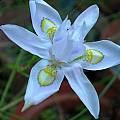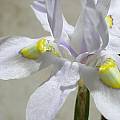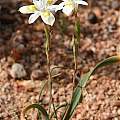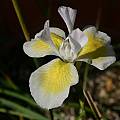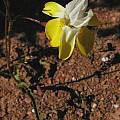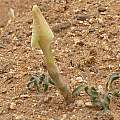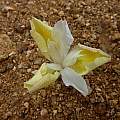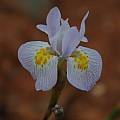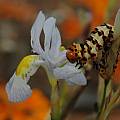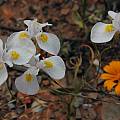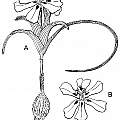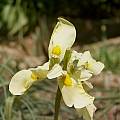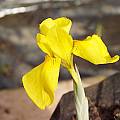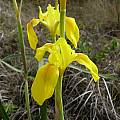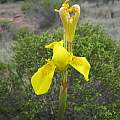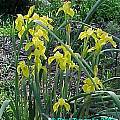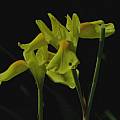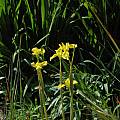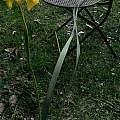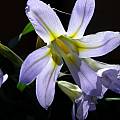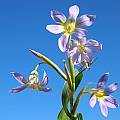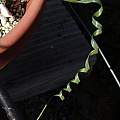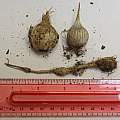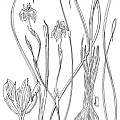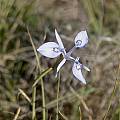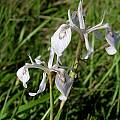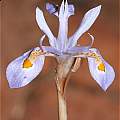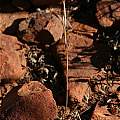The genus Moraea can be divided into five groups: Galaxia, Gynandriris, Hexaglottis , Homeria, and Moraea.
Moraea index lists all the species in all five groups alphabetically. More information can be learned from Peter Goldblatt's book on Moraeas.
Moraea group species s are found on this wiki page.
The other species in the Moraea group are listed alphabetically on these wiki pages: Moraea group a - Moraea group b - Moraea group c-e - Moraea group f - Moraea group g-i - Moraea group j-m - Moraea group n-r - Moraea group t - Moraea group u-v
Moraea saxicola Goldblatt grows on rocky granite or clay soils in Namaqualand. It has a single leaf and large flowers, usually white, but occasionally pale purplish blue. Inner tepals are large and reflexed like the outer tepals. Height: to about 35 cm. The first two photos taken by Alan Horstmann and the second two in habitat northwest of Steinkopf by Andrew Harvie.
Moraea serpentina Baker is a spring flowering species from arid parts of the interior and the northwestern Cape where it grows on dry stony flats and in crevices in granite rock. It has linear leaves that are twisted or coiled and white and yellow short lived flowers. Height range: 30-60 cm. The first photo was taken by Bob Werra and the second by Bob Rutemoeller of one blooming in the wild in the Little Karoo in September 2001 in a year with more rain in that area than usual. Photos 3-4 were taken by Cameron McMaster in Namaqualand September 2011.
In September 2006 we came across this stunning display of these plants in bloom driving from Nieuwoudtville to Vanrhynsdorp. Since these flowers are not open every day and also not very long during that day they are open, we considered ourselves very fortunate. Photos by Mary Sue Ittner of them in habitat and of one that has a bluish tint. Photos by Bob Rutemoeller of one with a caterpillar and a group of white ones.
Moraea singularis Goldblatt & J.C.Manning has a short underground stem, so it appears to grow at ground level. Pale yellow flowers with brown nectar guides, arranged in a cup shape. Blooms briefly, after the first rains of the season, in mid-winter (July-August). Native to granite gravel flats in central Namaqualand. Height: 18-30 cm. Drawing by John Manning shared with his permission from the Goldblatt and Manning paper naming eight new species. Figure notes: A, flowering plant; B, flower. Scale bar: 10 mm.
Moraea spathulata (L.f.) Klatt occurs at the edge of the winter rainfall area near Port Elizabeth all the way up the eastern parts of South Africa and into Mozambique and eastern Zimbabwe. Flowers appear at different times of the year depending on the locality. Plants are usually found in clumps, about 80 cm tall, each with a long persistent leaf and yellow flowers. Photos by Cameron McMaster taken in the Eastern Cape.
This is a rather striking evergreen moraea, looking at first glance to be an iris. It forms large clumps of rigidly upright stems of flowers, opening over a couple of weeks. Each bulb produces a single new leaf each year, followed by a solitary scape which contains a number of flowers which open in succession at the tip. The first photo shows an established clump in full flower in my garden. The first photo and description by Paul Tyerman. Two additional photographs taken by Mary Sue Ittner of plants that were planted and growing well at Kirstenbosch National Botanical Garden. The last photo shows a plant grown and photographed by Arte Cifuentes that demonstrates the remarkably long leaves of the species
Moraea speciosa (L.Bolus) Goldblatt is found on flats and lower slopes in the Roggeveld. It is blue with a pale cup and yellow nectar guides, and flowers in winter. The leaves are twisted like decorative ribbons. This is a desert species, growing in areas that have winters similar to Palmdale, California or Tehran, Iran. But it will survive in pots in areas with higher winter rainfall, if given good drainage. There are differing reports on how easy or hard it is to get the species to bloom. Height range: 40-75 cm. First two photos by Alan Horstmann. Leaf and corm photos by Michael Mace.
Moraea striata Goldblatt & J.C.Manning has khaki-colored flowers that open in early afternoon and close at nightfall. It has sticky stems and unusual V-shaped leaves, and is probably most closely related to the brown-flowered Moraea bubalina. It blooms in October. It grows at the foot of the mountains near Oudtshoorn, a desert region with about six inches (170 mm) of rain per year. Rainfall is spread through most of the year, with a brief dry period in mid-summer (December-February). Drawing by John Manning shared with his permission from the Goldblatt and Manning paper naming eight new species. Figure notes: A, flowering plant; B, androecium and style. Scale bar: A, 10 mm; B, 2 mm.
Moraea stricta Baker is a small species, about 20 cm tall, that is widespread in Africa. Plants are usually found in grassland, flowering at the end of the dry season before summer rains begin. It flowers without a leaf and has small blue-violet flowers with yellow-orange nectar guides on the outer tepals. The first two photos by Cameron McMaster taken in the Eastern Cape. Photos number three and four were taken by Andrew Harvie in the Magalisberg (NW of Pretoria).
Galaxia - Gynandriris - Hexaglottis - Homeria a-j - Homeria k-z - Moraea group a - Moraea group b - Moraea group c-e - Moraea group f - Moraea group g-i - Moraea group j-m - Moraea group n-r - Moraea group t - Moraea group u-v - Moraea hybrids - Moraea index
